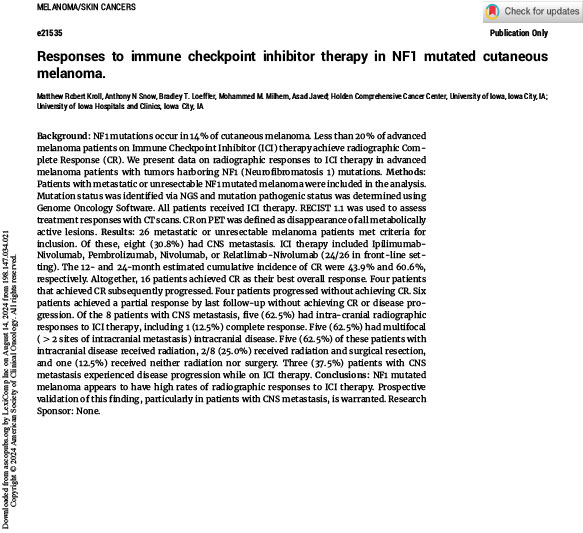Responses to immune checkpoint inhibitor therapy in NF1 mutated cutaneous melanoma.
May 2024
Abstract
Background: NF1 mutations occur in 14% of cutaneous melanoma. Less than 20% of advanced melanoma patients on Immune Checkpoint Inhibitor (ICI) therapy achieve radiographic Complete Response (CR). We present data on radiographic responses to ICI therapy in advanced melanoma patients with tumors harboring NF1 (Neurofibromatosis 1) mutations. Methods: Patients with metastatic or unresectable NF1 mutated melanoma were included in the analysis. Mutation status was identified via NGS and mutation pathogenic status was determined using Genome Oncology Software. All patients received ICI therapy. RECIST 1.1 was used to assess treatment responses with CT scans. CR on PET was defined as disappearance of all metabolically active lesions. Results: 26 metastatic or unresectable melanoma patients met criteria for inclusion. Of these, eight (30.8%) had CNS metastasis. ICI therapy included Ipilimumab-Nivolumab, Pembrolizumab, Nivolumab, or Relatlimab-Nivolumab (24/26 in front-line setting). The 12- and 24-month estimated cumulative incidence of CR were 43.9% and 60.6%, respectively. Altogether, 16 patients achieved CR as their best overall response. Four patients that achieved CR subsequently progressed. Four patients progressed without achieving CR. Six patients achieved a partial response by last follow-up without achieving CR or disease progression. Of the 8 patients with CNS metastasis, five (62.5%) had intra-cranial radiographic responses to ICI therapy, including 1 (12.5%) complete response. Five (62.5%) had multifocal ( > 2 sites of intracranial metastasis) intracranial disease. Five (62.5%) of these patients with intracranial disease received radiation, 2/8 (25.0%) received radiation and surgical resection, and one (12.5%) received neither radiation nor surgery. Three (37.5%) patients with CNS metastasis experienced disease progression while on ICI therapy. Conclusions: NF1 mutated melanoma appears to have high rates of radiographic responses to ICI therapy. Prospective validation of this finding, particularly in patients with CNS metastasis, is warranted.

